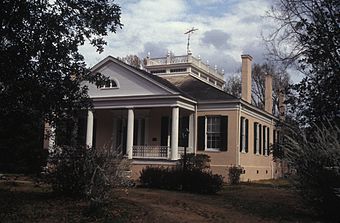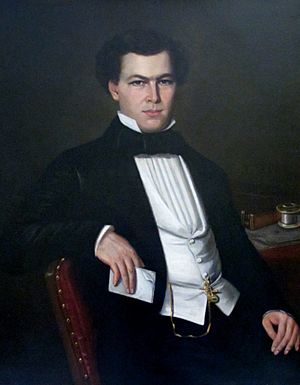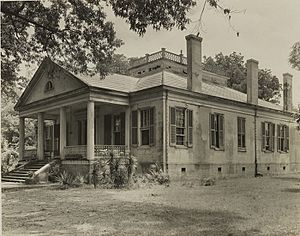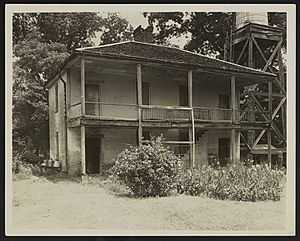Lansdowne (Natchez, Mississippi) facts for kids
Lansdowne is a historic mansion located in Natchez, Mississippi. It was built in the 1850s as the main home on a large plantation. Today, it is still owned by the family who first built it. Lansdowne is recognized as an important historical site and is listed on the National Register of Historic Places.
Where is Lansdowne Located?
Lansdowne is found on M.L. King, Jr. Road. It is about one mile north of the city limits of Natchez. The long driveway leading to the mansion is now called Marshall Road.
The Story of Lansdowne
Lansdowne was built by George Matthews Marshall and his wife, Charlotte Hunt. They built the mansion between 1852 and 1853. Charlotte's wealthy father, David Hunt, gave them the land. The land was 727 acres and was once known as the 'Ivy Tract.'
The couple named their new home Lansdowne after a friend from England, the Marquess of Lansdowne. This name made them feel like important landowners, similar to English gentry. Lansdowne was also next to Homewood Plantation, which belonged to Charlotte's sister.
Before the American Civil War (1861-1865), Lansdowne was a cotton plantation. Cotton was its main crop. The Marshall family also owned another plantation in Louisiana. This plantation, called Arcola, was across the Mississippi River.
The wealth of George Marshall and his family came from the forced labor of enslaved people. On Lansdowne, George Marshall had twenty-two enslaved people. His Louisiana plantation had 104 enslaved people. By 1860, his land and the enslaved people on it were worth a lot of money. His father, Levin R. Marshall, was also a very rich planter. He owned over 1,000 enslaved people before the Civil War. Portraits of George and Levin Marshall hang in the dining room at Lansdowne.
George Marshall fought in the Civil War. He was hurt during the Battle of Shiloh. After his injury, he returned home. He then paid someone else to take his place in the war.
During the war, in January 1865, some Union soldiers broke into Lansdowne. They tried to steal from the Marshalls. However, the butler, Robert, had hidden the family's silver under the floor. The soldiers did not find much. In frustration, they broke some of the family's fine dishes as they left.
After the Civil War, the Marshall family's wealth decreased. They no longer had the forced labor of enslaved people. Charlotte and her siblings used other properties and loans to support themselves. Sometimes, the family only had a small income from selling butter and eggs from their farm.
In 1932, something new helped the family. They started charging tourists to tour their historic home. This was part of the annual Natchez Pilgrimage tours. These tours brought in much-needed money to help keep the mansion going. A scene from the 1951 movie Show Boat (1951 film) was even filmed at Lansdowne Plantation.
The Marshall descendants sold their last cotton lands in the 1950s. Lansdowne was added to the National Register of Historic Places on July 24, 1978. In 1995, Devereaux Nobles and George Marshall IV, who are great-grandchildren of the original George Marshall, owned Lansdowne. The mansion and 120 acres of land are still owned by the Marshall family today.
Lansdowne's Design and Features
The mansion was built around 1853. It was designed in the Georgian Revival style. From the outside, the house looks smaller than it is. But inside, the rooms are very large. It has high ceilings and a long center hall, about 65 feet long. This hall makes the house feel grander than many other large Natchez mansions.
When you enter the front door, you are in the center hall. To the south of the hall are three bedrooms. To the north are the drawing room, dining room, and butler's pantry. A staircase in the butler's pantry leads to storage rooms. These rooms are in the attic and basement. The attic was nicely finished with gaslight fixtures. The basement had cellars for wine and dairy products.
The Marshalls finished the mansion quickly because the Civil War was approaching. They did not build the planned second floor. Because of this, the room meant to be a library became a bedroom instead.
Behind the house, there are two smaller buildings. These are called dependency structures. Before the Civil War, the north building held the kitchen, wash room, and servants' rooms. The south building had a billiard room, an office, a schoolroom, and a governess's room.
Lansdowne is important because it still has most of its original fancy interiors and furniture. Many items were brought from Europe. The front parlor has one of the best-preserved Rococo Revival style interiors in Mississippi from the mid-1800s. The house features rare Zuber & Cie wallpaper. It also has furniture made of rosewood and mahogany. The fireplaces have mantelpieces made of Egyptian marble. George Marshall I bought the rosewood parlor set and Zuber & Cie wallpaper on a trip to France.
Some of the wooden baseboards are painted to look like oak or marble. The bronze chandeliers in the house used to be powered by gas. This gas was made at the plantation's own gas works.
To keep the house comfortable, a bathroom was added in the early 1900s. Electricity was installed in the 1940s. In 1962, a kitchen was put into the butler's pantry. A second bathroom was added to a bedroom corner. These changes were made carefully to protect the original design.
Outside, the property covers 140 acres. It includes Spanish moss, streams, and woodlands.








